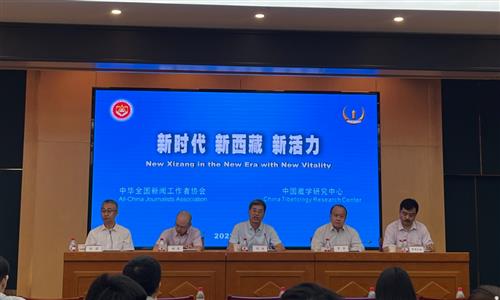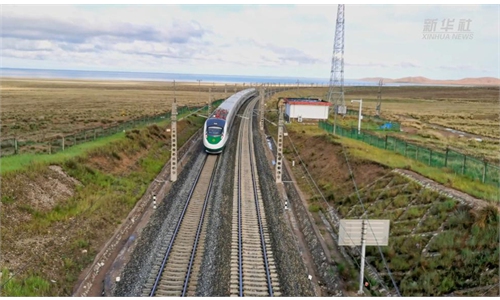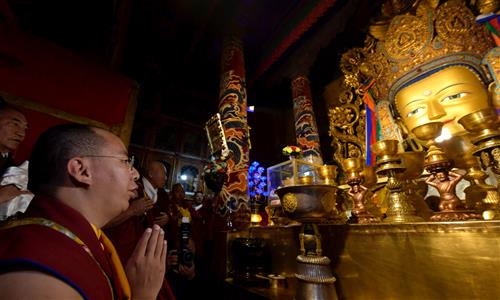Xi’s footsteps in Xizang region illustrate beautiful new chapter for snowy plateau
A new starting point
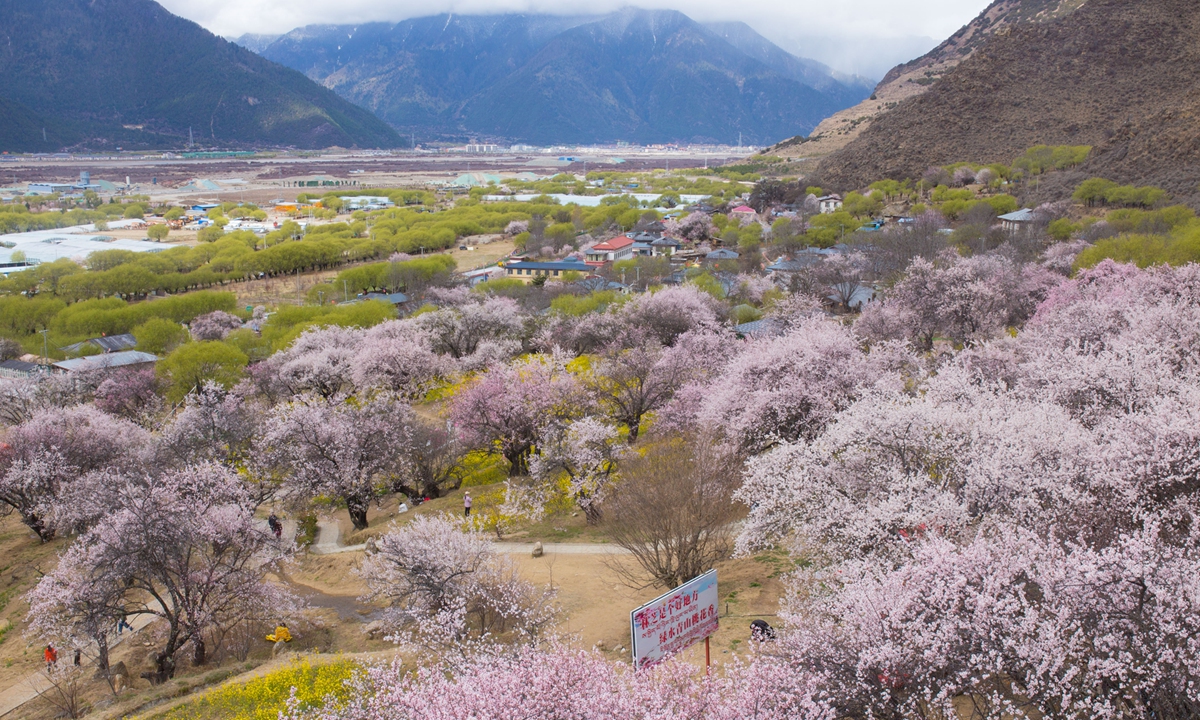
Peach flowers bloom in Galai village, Nyingchi, Southwest China's Xizang Autonomous Region, in March 2023. Photo: Shan Jie/GT
The average altitude of the Xizang (Tibet) Autonomous Region in Southwest China is over 4,000 meters above sea level, making it a harsh environment for survival since ancient times. However, today, on the Roof of the World, the picture of a happy life is unfolding, and a new chapter in Xizang's history is being written.
Two years ago, Xi Jinping, general secretary of the Communist Party of China Central Committee, Chinese president, and chairman of the Central Military Commission, visited the Xizang Autonomous Region from July 21 to 23, 2021 for the 70th anniversary of Xizang's peaceful liberation, the first time in the history of the Party and the country.
During his trip, Xi extended his congratulations for the 70th anniversary of Xizang's peaceful liberation, visited officials and ordinary people from various ethnic groups, and conveyed the CPC Central Committee's care to them.
Xi said that over the last 70 years, Xizang has made historic strides in the social system and realized full economic and social development, with people's living standards significantly improving.
"It has been proven that without the CPC, there would have been neither new China nor new Xizang," Xi said. "The CPC Central Committee's guidelines and policies concerning Xizang work are completely correct."
The Chinese president also stressed fully implementing the guidelines of the CPC for governing Xizang in a new era and writing a new chapter of lasting stability and high-quality development for the plateau region.
Two years later, following Xi's footsteps, the Global Times reporters visited some key spots in Xizang region, witnessed the happy lives of local residents, the practice of Chinese modernization in the region, as well as the maintaining of rich cultures on the plateau.
Tender care
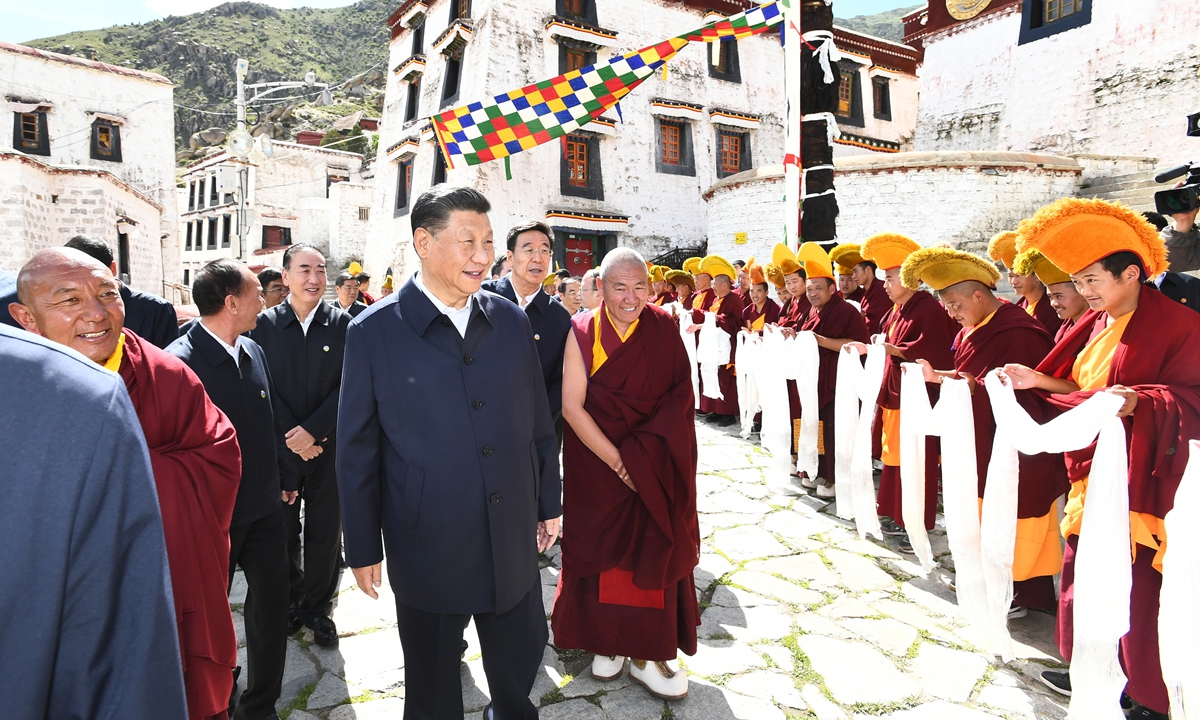
Xi Jinping, general secretary of the Communist Party of China Central Committee, Chinese president, and chairman of the Central Military Commission, visits the Drepung Monastery in Lhasa, Southwest China's Xizang Autonomous Region, on July 22, 2021. Photo: Xinhua
"Who brought the ancient call, and who left behind the millennium's prayers?"
These well-known lyrics in China not only depict the customs and culture found on the Qinghai-Xizang Plateau, but also express the local people's desire for development.
Xizang, the land that accounts for about one-eighth of China's total land area, was once the region with the highest rates of poverty. It used to be the only provincial-level concentrated contiguous area with extreme poverty in the country.
Through pragmatic and effective measures such as poverty alleviation through production development, relocation of impoverished populations, and ecological compensation, the combination of strategies has been successful in alleviating absolute poverty in the region.
By the end of 2019, all 74 poverty-stricken counties and districts in Xizang had shaken off poverty, and over 620,000 impoverished individuals had been lifted out of poverty.
Dawa Gyaltsen is one of the individuals who gained deep experience from Xizang's transformation.
Dawa, a villager from Galai village in Nyingchi, Xizang, lives in a Tibetan-style courtyard. Over the years, thanks to an increase in income, the small courtyard has become increasingly beautiful.
On July 21, 2021, Xi visited the home of Dawa and chatted with him and his family members in the living room.
Xi said the village epitomizes the economic and social achievements Xizang region has made over 70 years since its peaceful liberation. He also hailed the village as a model of ethnic unity. The president later visited a city park in Nyingchi where he greeted dancing locals and tourists.
"When the president visited my home, he asked very detailed questions about various aspects of our lives. I was surprised by his concern," Dawa told the Global Times, expressing his gratitude for Xi's tender care.
Galai village is situated at an altitude of 2,900 meters. Every spring, more than 1,200 wild peach trees bloom in succession, creating an enchanting landscape.
Leveraging this unique resource, the village has developed its tourism industry. In 2022, the village's tourism income reached 4.6 million yuan ($640,000), and all 33 households in the village received dividends, including Dawa Gyaltsen's family.
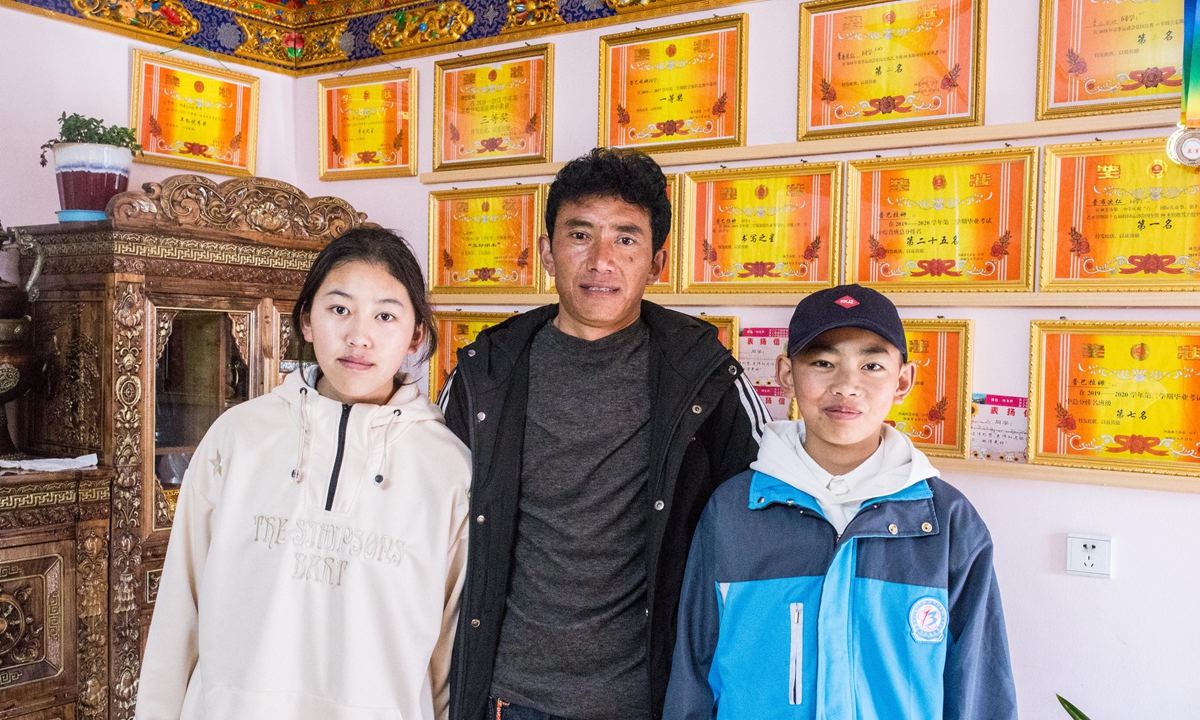
Dawa Gyaltsen and his children. Photo: Shan Jie/GT
In addition to running transportation, which earned him over a hundred-thousand-yuan from 27 acres of leased land and the specialty agricultural and pastoral products from 40 heads of livestock, Dawa Gyaltsen's family achieved an annual income of 350,000 yuan.
Dawa Gyaltsen's two children currently attend a boarding school in the city of Nyingchi, returning home at weekends. The living room wall in their home is adorned with certificates and awards earned by his daughter and son, ranging from academic achievements to handwriting and sports. "My daughter wants to become a doctor, and my son aspires to be a sprint athlete," he proudly shared with the Global Times reporters.
Witness to modernization
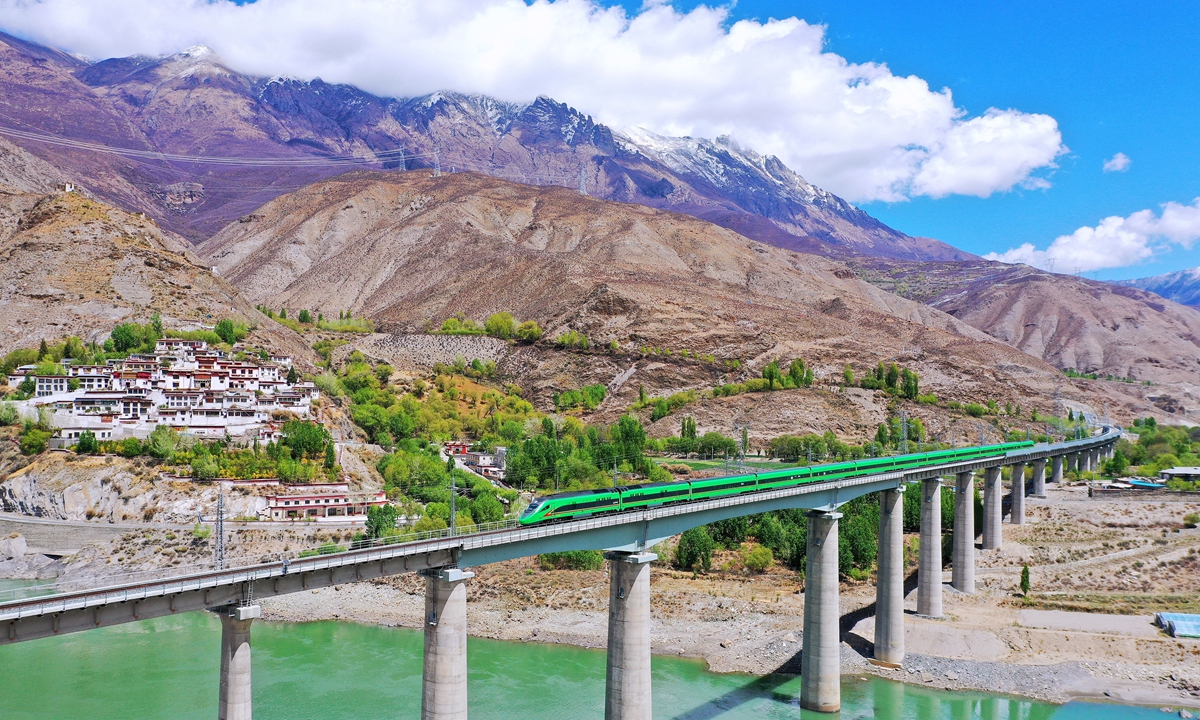
A Fuxing bullet train travels in Nyingchi, Southwest China's Xizang Autonomous Region, on April 14, 2022. Photo: Xinhua
During his visit, Xi went to the Nyingchi Railway Station, learning about the overall design of the Sichuan-Xizang Railway line and how the Lhasa-Nyingchi section has operated since June 25, 2021.
Aboard a train to the region's capital of Lhasa, Xi inspected construction along the railway route. He hailed the railway line as a major move to boost Xizang's development and improve people's living standards.
With a designed speed of 160 kilometers per hour, the 435-kilometer railway marks the launch of the country's first electrified railway route operating in the plateau region. As it crosses over the surging Yarlung Zangbo River, the Fuxing bullet train traverses the snowy plateau, bearing witness to Xizang's modernization and the fruitful outcomes of its frontier development and border security efforts.
On the C881 high-speed train from Lhasa to Nyingchi, the Global Times reporters saw not only tourists from across the country, but also many local residents shuttling between cities and counties.
Zhang Kun is a driver who operates Fuxing trains on the Lhasa-Nyingchi Railway line. When asked about his experience being a locomotive driver on the world's highest electrified railway line, Zhang told the Global Times that since he started working in 2007, he has been driving trains on the Qinghai-Xizang Plateau.
He said that he has operated various trains including domestically-produced Dongfeng-4 locomotives, imported NJ2 locomotives from the US, domestic Hexie bullet trains, and Fuxing bullet trains. He feels that the trains running on the Qinghai-Xizang Plateau have become increasingly advanced.
"The Lhasa-Nyingchi Railway crosses the Yarlung Zangbo River 16 times along its route, with over 90 percent of the tracks laid above an altitude of 3,000 meters," Zhang said.
"However, driving on this line is not difficult. Nowadays, locomotives are becoming more advanced, and for locomotive drivers, operations have become more convenient," Zhang explained.
At the end of 2012, the total length of roads in Xizang was only 65,200 kilometers. A decade later, the total length of roads open to traffic in the region has reached 121,400 kilometers. The length of highways and expressways open to traffic in the entire region has increased from just 38 kilometers at the end of 2012 to the current 1,105 kilometers, and the three-hour comprehensive transportation circle centered on Lhasa is rapidly taking shape, the Global Times learned from Dawa Ouzhu, the Party Secretary and Deputy Director of the Xizang Regional Transportation Department.
The length of rural roads in the Xizang region increased from 53,200 kilometers at the end of 2012 to 90,400 kilometers in 2022, and their accessibility and smoothness have been greatly improved, the Global Times learned from the regional transportation department.
The transformation network in Yumai, a small border township in Xizang, is the epitome of how border regions have developed in the last decade under the leadership of the CPC.
Yumai in Shannan, Xizang, was China's smallest township in terms of population. With improved transportation and infrastructure, the remote township has now taken on a new look.
Today, Yumai has become a model village in achieving moderate prosperity, with the complete construction of the highway and its year-round accessibility. The specialized transportation line from Yumai to Shannan city is now operational. The entire township of Yumai has seen improvements in infrastructure, from paved roads and internet coverage, to enhanced education and medical services.
Well-passed traditions, cultures
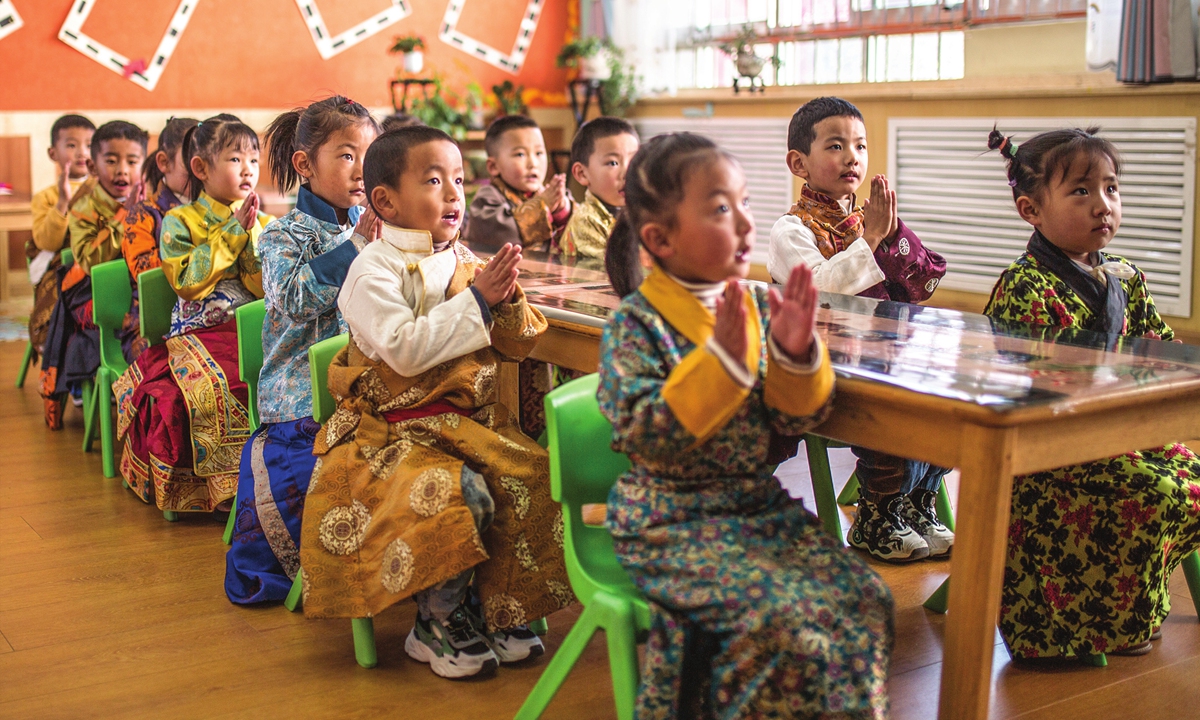
Children dressed in traditional Tibetan costumes study in a class at the Lhasa Experimental Kindergarten in March,2023. Photo: Shan Jie/GT
The publicity and education work of building ethnic unity and progress public awareness should be combined with the education work concerning core socialist values, patriotism, anti-secessionism, history, and Marxist concepts, Xi said after hearing the reports of the Party committee and government of Xizang Autonomous Region on their work in Lhasa on July 23, 2021.
He called for the strengthening of exchanges and interactions among ethnic groups, as well as building a stronger sense of identity tied to the Chinese nation, Chinese culture, the CPC, and socialism with Chinese characteristics.
During a recent visit to kindergartens and schools in Xizang region, the Global Times reporters felt the successful implementation of this principle. Tibetan children in Lhasa were proficient in both Putonghua and Tibetan, skillfully expressing themselves in both languages.
Children at the Lhasa Experiment Kindergarten immerse themselves in the local traditional culture, telling stories in Tibetan, playing traditional board games, learning Tibetan dances, and dressing in Tibetan costumes. They joyfully embrace these activities as a part of their daily life.
At the nearby No.1 Primary School in Lhasa, second graders diligently learn how to read and write Tibetan in addition to mastering Putonghua. The Xizang education system places great importance on ensuring that students of Tibetan ethnic group systematically learn and grasp the local language.
When the Global Times arrived at the Drepung Monastery one afternoon, more than a hundred young lamas were engaged in a scripture debate, an essential part of learning in Buddhist teachings in the Tibetan Buddhist system.
The lamas were dressed in traditional maroon robes, holding prayer beads, and enthusiastically clapped their hands while asking their peers questions or confidently providing answering, and occasionally falling into contemplative silence.
Immersed in their discussions, they were completely undisturbed by the presence of tourists around them. After two hours of scripture debate, the lamas left the debate area with smiles and laughter, walking together in groups.
During his visit to the monastery located in the western suburbs of Lhasa in July 2021, Xi acknowledged the contributions the monastery has made in upholding the leadership of the CPC, supporting the socialist system, and safeguarding national unity.
Xi stressed the full implementation of the Party's fundamental guidelines governing religious work, respecting the religious beliefs of the people, and adhering to the principle of independence and self-governance in religious matters.
At Lhasa's Barkhor Street, Xi visited shops and learned about the development of tourism and cultural industries, as well as the preservation of Tibetan culture. On the street, people from various ethnic groups greeted Xi, who waved back.
At present, Xizang region is at a new historical starting point in its development, and the Party's leadership must be upheld and the path of socialism with Chinese characteristics must be followed, Xi said.


